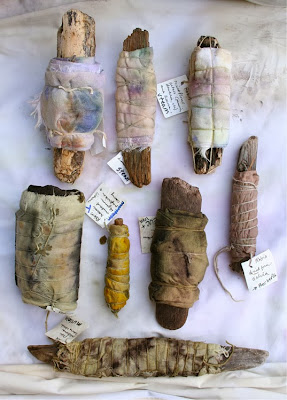Macramé
If you're around my age, the word "macramé" conjures up a host of crazy, knotted memories from the late 1960s and early 1070s - Although the pieces shown below were not made by me, I certainly did some very similar work. Sadly, it's all gone and I have no pictures of it...
It started with one ball of string and a few plant holders,
which got bigger and fancier as we got hooked on knotting.
Belts and
purses were next for me,
followed by bottles!
We graduated to more and bigger balls of string
as we started making whole room dividers and curtains!
But after a year or two,
we grew tired of wooden beads, plain string and cramping fingers.
We moved along to something else, never looking back...
until now!
Introducing... ta-dah...
Micro-macramé!
This is a necklace designed and knotted by Joan Babcock, one of today's most talented and prolific macramé artists. I've been smitten with her work ever since a friend gave me a link to her
website. This particular piece is an example of a type of macramé called Cavandoli knotting.
Needless to say, after seeing Joan's micro-macramé jewelry and sculptural pieces on her website, my interest in knotting was re-kindled! Thus I hounded the program chairman of our local textile guild until she booked Joan to come teach for us. A couple of weeks ago, she arrived, fresh and genuine from Santa Fe, ready to share her techniques, design process, and art with us for two days of class and a slide lecture.
The first day, we knotted this bracelet, using diagonal double half hitches and square knots. I found the knotting came back quickly, some sort of kin-esthetic finger memory from 50 years ago surfacing almost immediately!

The second day, we learned Cavandoli knotting, a combination of horizontal and vertical double half hitches, and made this pendant. The cord is #18 nylon, sold in bead shops as S-lon or micro-macramé cord, available in more than 50 colors, a long way from plain old white cotton string we used half a century earlier. Cavandoli knotting results in a solid piece, with the colors variable. It reminds me both of fair isle knitting (where the non-active color of yarn is carried behind the work), and of needle point (where each stitch is distinct). The pendant is only an inch square, and there are 680 knots if you count each double half-hitch as two knots. Obviously, you have to like "small" to want to do this work, as the knots are each about as small as a size-15 seed bead, maybe a bit smaller.
If you know me, you know I like small. I am so hooked! Fortunately I have a stash of the cord in various colors (because it's what I use for
finger weaving) and a few (LOL) beads. Because Joan's teaching and
books are fabulous, clear, step-by-step, and enabling, I had no trouble at all getting started. Here's what I've made in the past two weeks...
First I made a couple pair of earrings to go with my corduroy "big shirts."
These took about 1.5 hours per earring to make.
Then, copying the design idea from a bracelet Joan was wearing while teaching, I started this bracelet to match the second pair of earrings. I ran out of the crystals along the outside two arcs before finishing it, and am waiting now for my order to arrive from
Fusion Beads.
Three days before departing for this year's quilt camp, where we are supposed to wear name tags,
I got the idea of trying my hand at Cavandoli knotting to make a pin with my name done in knots.
At 6 AM the next morning, I was still knotting.
Yikes, talk about sore shoulders and fingers.
But the next day, I finished it! Ta-dah:
The knotted part of his one is 1.75 x 1.5 inches, a total of 1,536 knots!
I've sewn a piece of Ultrasuede to the back of the knotting, hiding the cord ends,
which are folded and stitched to the knotting.
The final step was to sew a bar pin to the back, by stitching to the front side between rows of knotting, invisible from the front, but secure. The bar pin is one I had in my stash for a long time. Unfortunately it broke immediately when I put on the pin at quilt camp. I had to temporarily sew a safety pin to the back in order to wear it.
Which brings me to the final point of this post....
Where can I find GOOD QUALITY bar pins?
They all seem so terribly cheap, all looking like the one I used,
all wanting to fall apart at the first touch.
Please comment with your recommendations!
Thank you,
Joan! Your workshops, slide lecture, and books have inspired and pleased me beyond measure!
If you like what you see here, I recommend
Joan's books and DVD. You can learn it from her even if you never got hooked in the 60s. Her kits are great too, wonderful for those who don't have a stash of beads/cords, and want to get started, to see if you like doing the knotting! Her kits are listed on her website on the same page as the books and DVD. And, good news, she's working on her next book and more kits!


































































